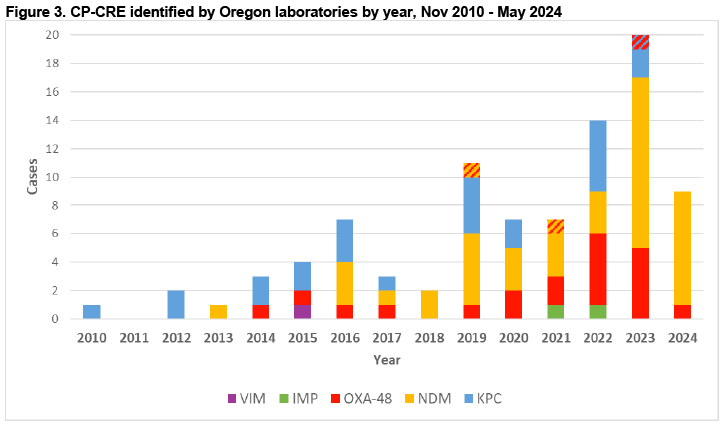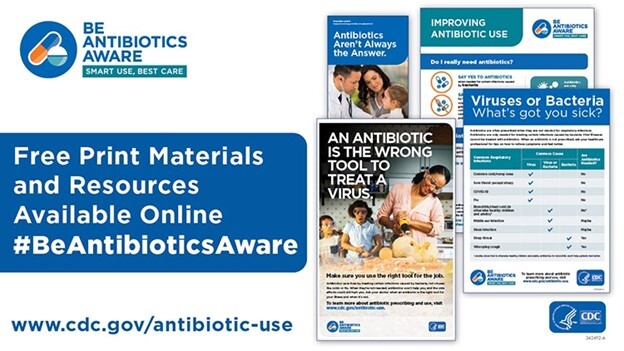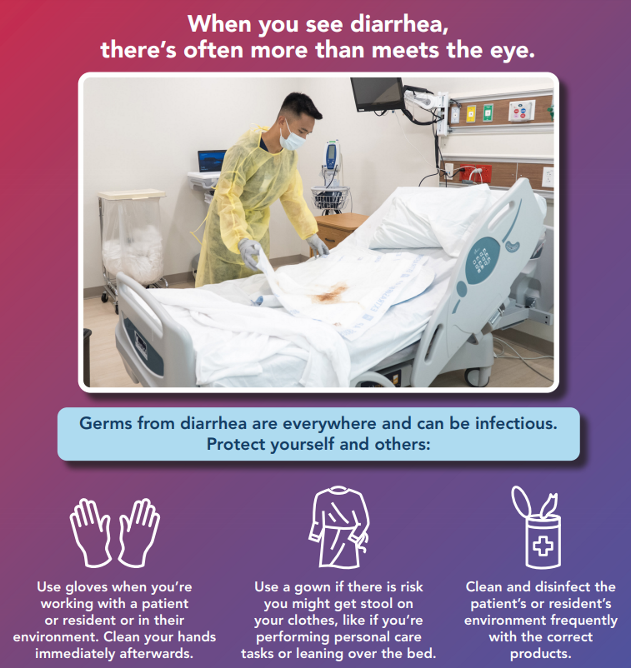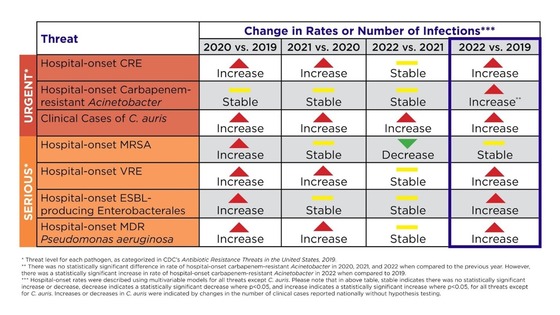|
Clostridioides difficile – a bacterium that can cause life-threatening diarrhea – was the most common pathogen found in the 2011 and 2015 Healthcare-Associated Infections and Antimicrobial Use Prevalence Surveys. It is also identified as an Urgent Threat in CDC’s 2019 Antibiotic Resistance Threats Report. C. difficile infection (CDI) is common after antibiotic therapy, which destroys many of the normal bacteria in the intestines.
To address this public health priority, OHA conducts population- and laboratory-based C. difficile infection (CDI) surveillance with nine other states through the Emerging Infections Program (EIP). When a case is reported to public health, the Oregon HAI program collects detailed patient data to identify and monitor CDI trends in community and healthcare settings.
Surveillance in Oregon started in 2010 and is focused in Klamath County. Surveillance in Klamath County provides a unique opportunity to inform the changing epidemiology of C. difficile, particularly when it comes to antimicrobial stewardship efforts and education to address community-acquired CDI in an outpatient setting. Cases have remained steady over the last several years, averaging about 100 incident cases per year. More than half of cases are community-associated, meaning CDI occurred among those with no recent hospitalizations or stays at a long-term care facility. This is similar to national trends, in which community-acquired cases are increasing.
Current strategies to reduce C. difficile infections include improving the judicious use of antibiotics, infection control, and healthcare facility cleaning and disinfection.
EIP CDI surveillance program
About C. diff
Progression of a C. diff infection
C. diff facts for clinicians
|
|
-
The Healthcare-Associated Infections (HAI) Program is excited to present Oregon’s Antimicrobial Stewardship (AMS) Honor Roll. The honor roll was developed to:
-
Recognize acute care and critical access hospitals meeting each of the CDC's seven core elements and working toward meeting priority core elements of antimicrobial stewardship
-
Promote appropriate use of antimicrobials
-
Prevent emergence of antimicrobial resistance
-
Showcase the work of antimicrobial stewards across Oregon
-
Honor facilities with bronze, silver, and gold level recognition of their stewardship programs’ alignment with evidence-based best practices.
How Your Facility Can Apply:
-
Oregon Carbapenemase-producing Carbapenem-resistant Enterobacterales cases through May 2024.
 |
-
ACE Coaching to Certification Program: In partnership with Comagine Health, the HAI Program launched the Advancing Infection Control Capacity & Education (ACE): Coaching to Certification Program in 2022. The program provided infection prevention coaching, education, test preparation and support to more than 100 individuals throughout Oregon’s licensed long-term care facilities. The goal of this project is to enhance Certified Infection Prevention and Control (CIC) exam readiness for eligible IP staff working in Oregon’s skilled nursing facilities, assisted living and residential care facilities. We recently concluded our second cycle of the ACE Program “ACE at Your Pace,” and are proud of our participants sitting for their CIC exam this spring and summer. Reach out to Bailey Weissenfels, if you’re interested in the ACE Program.
-
IP Champions Program: In April 2023, Oregon Project Firstline launched the Infection Prevention (IP) Champions Program by recruiting 26 members from 24 of Oregon’s local public health departments to create a network of infection prevention and control (IPC) subject matter experts across Oregon’s communities. This cohort met monthly over the last year for trainings and discussion opportunities covering a variety of IPC topics. We completed our first cohort in April 2024 and are looking for ways to continue this learning collaborative. Reach out to Nick Ida if you want to learn more.
-
OHA’s Healthcare Associated Infections Program released Multidrug Resistant Organism screening recommendations. We recommend that Oregon hospitals and ventilator-capable skilled nursing facilities screen for Candida auris and carbapenemase-producing organisms, in patients who in the past 12 months:
- Spent the night in a healthcare facility (hospital or long-term care) outside of Oregon or
- Had outpatient surgery, or hemodialysis outside the US or Canada.
Testing is provided at no cost to facilities. Contact us to get started.
-
Order Be Antibiotics Aware and CDI materials today.
Did you know? CDC offers free patient and healthcare professional resources for appropriate antibiotic use and healthcare professional resources for CDI.
Antibiotics can save lives; however, the use of antibiotics increases a patient’s risk of adverse events, including CDI, a condition that may require immediate treatment. Optimizing antibiotic therapy can help protect patients from this potentially deadly infection and combats antimicrobial resistance.
With U.S. Antibiotic Awareness Week (November 18-24) and CDI Awareness Month (November) approaching, CDC encourages you to take advantage and order Be Antibiotics Aware print materials to raise awareness about these important topics.
You play a vital role in improving antibiotic use and protecting your patients from CDI. We appreciate your continued support.
 |
-
Do you need continuing education credits? Oregon Project Firstline in partnership with the Oregon Medical Association is providing free continuing education (CME) credits on infection prevention and control (IPC). These online webinars include an overview of Oregon Project Firstline and refresher education on IPC topics like identifying and isolating contagious patients. We have two webinars with more on the way! Questions? Email Oregon Project Firstline.
Infectious Insights
Check out the newest @CDCProjectFirstline micro-learn training on what to do when you see diarrhea. Train your team to recognize infection risks and stop the spread of germs.

-
C. auris cases are increasing in Washington State. The first case was identified through a proactive admissions screening program in 2023. From January through May 2024, 14 more locally acquired cases have been identified. Per our recent recommendations, Oregon acute care hospitals are encouraged to implement admissions screening for patients with healthcare exposures outside of Oregon.
- CDC published a new fact sheet on the burden of seven antimicrobial resistant pathogens typically found in healthcare settings. Clinical cases of auris increased 5-fold from 2019 to 2022.

|
|
- Join the HAI Program for a webinar at noon on September 18th, titled Admission Screening for High-priority Multidrug-resistant Organisms (MDROs) in Oregon Healthcare Facilities. We’ll spend an hour reviewing new MDRO screening recommendations, and hearing from Infection Prevention (IP) leaders in Oregon that have implemented admissions screening in their facility. Register now, and send us your questions.
|
|
|
Get to know the exceptional members of the HAI team. This month we meet Valerie Ocampo.

Valerie is our HAI Public Health Nurse within the Emerging Infections Program. Valerie joined the Oregon Health Authority in 2011. She is the CDI surveillance officer and oversees other EIP activities including the Healthcare Associated Infections and Antimicrobial Use Prevalence Survey and a project to address COVID-19 among healthcare workers. She has co-authored multiple manuscripts related to these projects.
Valerie received her Bachelor of Science in Nursing degree from Oregon Health & Science University and worked in elder care and chronic care management before moving across the globe to Australia where she received her Master of International Public Health (Hons) at the University of Sydney. Valerie currently holds a Certificate in Infection Control.
When not completing a case report form, Valerie enjoys baking while listening to a favorite podcast, cross-stitching, or reading a cozy fantasy novel. She finds joy in traveling and aims to travel somewhere new every year. Some of her favorite countries she visited include Portugal, Switzerland, Japan, and Singapore. This year, Valerie is going to try her hand at watercolor painting.
|
|
|
|
Do you have a question about antimicrobial stewardship? Send it to us, and Liz Breitenstein, PharmD, RPh, Antimicrobial Stewardship Pharmacist, will answer it in a future edition.
One of the primary risk factors for Clostridioides difficile infection (CDI) is previous exposure to antibiotics, making antimicrobial stewardship a critical first line of defense. Implementing antimicrobial stewardship programs (ASPs) not only ensure that patients diagnosed with CDI receive appropriate antibiotic therapy for their infection, but also play a pivotal role in preventing CDI by ensuring that patients with other infections receive appropriate antibiotics.
Some antibiotics are more likely to predispose patients to CDI; these include clindamycin, fluoroquinolones (e.g., ciprofloxacin or levofloxacin), and third- and fourth-generation cephalosporins (e.g., cefepime, ceftriaxone, cefdinir, cefixime). It is important to assess the need for these higher-risk antibiotics before prescribing. However, almost all antibiotics have been associated with CDI, so it is also important to assess patients’ individual risk for CDI, and discuss with the patient when prescribing any antibiotic. Other risk factors include previous history of CDI, age 65 and older, extended stay in healthcare settings, and immunocompromising conditions.
Reducing antibiotic exposure is a risk factor with the potential for significant impact. Studies show that a significant portion of antibiotic use in hospitals is inappropriate, highlighting the need for effective stewardship. A 2021 CDC study found that 56% of antibiotic use in US hospitals was not supported by clinical evidence, often due to incorrect antibiotic selection or unnecessarily long treatment durations. Two meta-analyses suggest that implementation of an antimicrobial stewardship program reduced CDI incidence by 30%–50%.
In addition to ASPs, another strategy essential for preventing CDI is implementing diagnostic stewardship to ensure that C. difficile testing is being performed appropriately. To avoid misdiagnosis and unnecessary antibiotic use. Learn more about CDC Clinical Testing and Diagnosis for CDI.
|
|
I work at an outpatient provider’s office. Our restrooms are cleaned daily, but we have patients collect urine specimens in the bathroom throughout the day. Should we be disinfecting the bathroom between each specimen collection?
Great question! When patients collect their own specimen, they will touch many bathroom surfaces in the process. These patients may carry very resistant bacteria. So yes, high-touch bathroom surfaces should be disinfected between patients.
One way is to engineer the environment to make it easy and help staff to remember to disinfect between each patient.
-
Avoid using pass through specimen windows. Staff may disinfect the inside of the frame. However, the parts that the patient touches with soiled hands are inside the bathroom and are likely not getting disinfected. It’s best to avoid using these windows.
-
Have staff enter the bathroom to collect specimen containers. If staff need to enter the bathroom to get the specimen cup, they are more likely to remember to disinfect the high-touch surfaces at the same time. Make sure you have a germicide available. You can use a tray to collect specimen cups. The tray can be easily disinfected or changed between patients.
-
Disinfect these 8 surfaces: Doorknob & toilet flush handle, toilet seat, grab rails, soap dispenser, faucet handles, dryer nob, and specimen tray.
Cartoonist: Gary Larson - http://thefarside.com
Enjoy a dose of infectious humor with a HAI-larious joke that's sure to brighten your day! Have a great joke in mind? Send us your jokes and we’ll feature you in one of our upcoming newsletters.
|
|

Sign up for our newsletter to receive regular updates, explore new resources added to our website, and reach out to us with any questions or ideas you'd like to see in future newsletters. Let us know!
-
Sign up for our newsletter.
-
Share your feedback/suggestions/topics for future newsletters.
- Visit our website.
|
|
|
|
Oregon Health Authority works to transform the health care system in Oregon by lowering and containing costs, improving quality and increasing access to care to improve the lifelong health of Oregonians. OHA is overseen by the nine-member citizen Oregon Health Policy Board working toward comprehensive health reform in our state.
The HAI program within the OHA Public Health Division is dedicated to preventing and containing healthcare-associated infections (HAIs) and addressing the growing challenge of antimicrobial resistance (AR). Through initiatives such as the Antimicrobial Resistance Laboratory Network (AR Lab Network) and the National Healthcare Safety Network (NHSN), we are bolstering our ability to detect and respond to antibiotic resistance while strengthening the nation's most widely used HAI tracking system. We also focus on antibiotic stewardship to improve the appropriate use of antibiotics, and we provide comprehensive infection prevention and control (IPC) education and training to equip the health care workforce with the necessary skills. Our team further offers IPC consultations to health care facilities throughout the state, providing expert guidance and support in implementing effective infection prevention strategies and responding to outbreaks. Together, we are committed to enhancing patient safety and reducing the impact of HAIs and antimicrobial resistance.
|
|
|
|
|